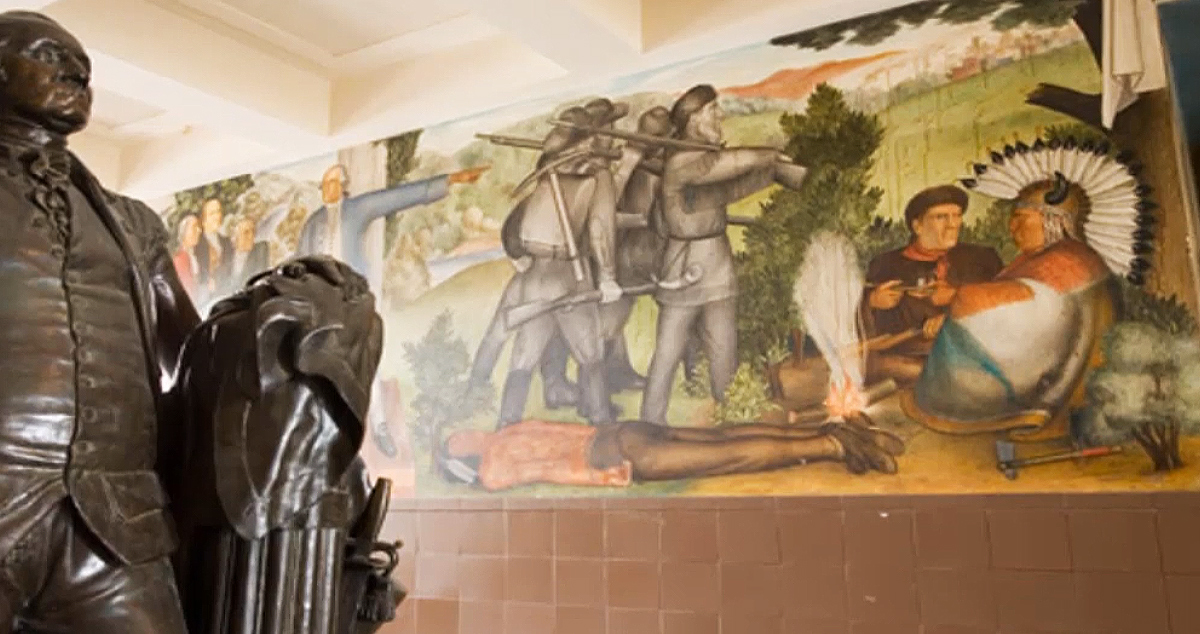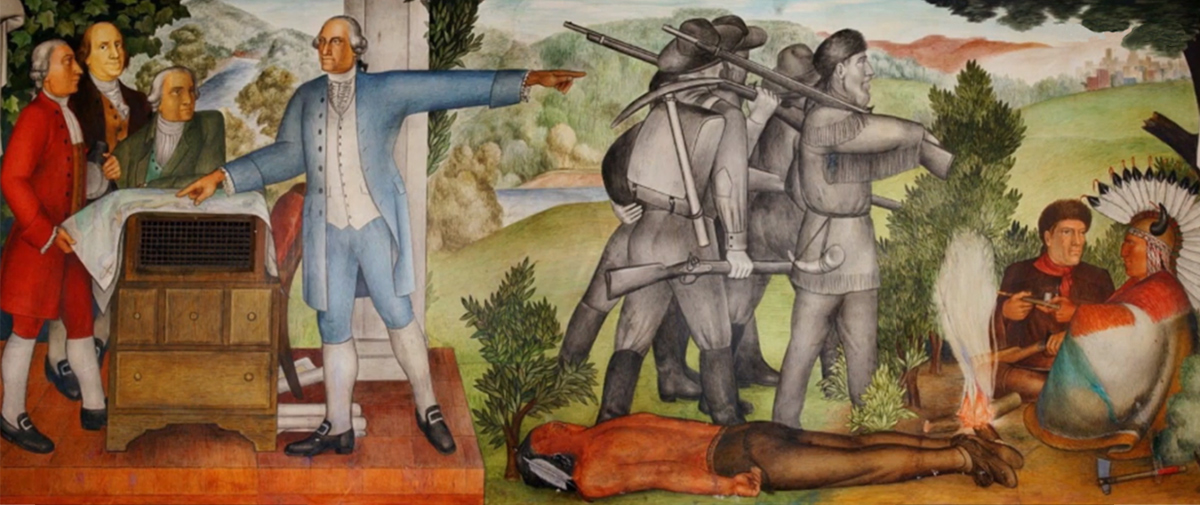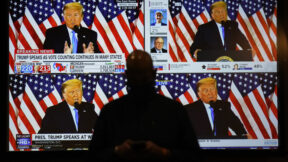Political Correctness Goes to War With Itself Over George Washington Mural

In what may at first glance seem a surprising opinion, the LA Times editorial board this week came out against the destruction of a mural in San Francisco depicting George Washington. The mural is under fire over the impact it has on students and the “changing sensitivities” of modern America.
However, what may sound like a stand against “political correctness” isn’t exactly the clarion that defenders of, say, a Robert E. Lee statue may think. In the case of the Washington mural, it’s more complicated.
The mural, “Life of Washington,” has been in the news nationally for a few weeks, though not quite a top tier story. It is on the wall at George Washington High School in San Francisco, and has been for 83 years. It was painted by Victor Arnautoff, a celebrated depression-era artist, who painted one of San Francisco’s famous Coit Tower murals under the same Public Works of Art Project that led to the Washington work.
The San Francisco Board of Education voted unanimously in June to paint over the mural, citing, among other concerns, “changing sensitivities.” One might generously interpret that to mean changing “sensibilities,” but the “sensitivities” label was used, and triggered some backlash against “snowflakes” online.
The San Francisco School Board’s decision to paint over the 83-year-old mural is prompting some to worry that other artwork from the so-called New Deal era could face a similar fate because of changing sensitivities. – AP
But it is not a clear-cut, left-right issue, as professors from both UC Berkeley and San Francisco State University have pointed out. The mural depicts Washington as a slave-owner, as well as the expansion west trampling over the death and destruction of Native Americans.

“We on the left ought to welcome the honest portrayal,” argued Richard Walker, a professor emeritus at Berkeley.
In their opinion, the LA Times editorial board agreed, and particularly noted the clash between that American left impulse to protect sensitivities, and that American left impulse to expose the dark side of American history.
Rather than the usual left-right divide, in this instance the fight is primarily among liberals — those who want the mural removed because they consider it a traumatically offensive reminder to Native American and African-American students of a horrible past, and those who defend the mural as an honest and anything-but-racist representation of the nation’s history, including its less-than-admirable aspects. Talk about a teachable moment.
In their conclusion, they concur with Walker.
It’s one thing to remove memorials that celebrate or advance a false narrative about the past, such as the notion that the Civil War was about something other than defending slavery and white supremacy. But painting over murals that accurately reflect our history because the truth might offend viewers moves us in the wrong direction.
In this, they touch on without quite capturing a very important point in the periodic national clamor over this or that historic monument, landmark, or figure: the artistic and historic intent.
The Board argues that removing memorials that depict a “false narrative” is one thing, but this is different. It’s apt that the words here are “paint over”, because it is not just the painting over of murals but of the past that is at issue. Most on the left would interpret this to mean that racist Republicans want to paint over past American sins, but it is a far more complicated issue than merely our current political moment.
Human beings, one can argue, are far more complicated creatures than the history they are responsible for. Robert E. Lee, to choose an example, is more complicated as a person than the historic events in which he participated. It is easy to know the good guys (against slavery) and the bad guys (for slavery). It’s easy to sort it out broadly, and particularly in the sense of which side should win in a war. The bad guys should lose. The Confederates were the bad guys.
But it is harder to understand an individual human being from those eras. Some from George Washington’s era, for example, who as hard as it may be to comprehend may very well have felt themselves morally in objection to slavery while also actively participating in it.
It is tempting to think of a statue — or as some (including the LA Times) often put it, “memorial” — as something that honors the totality of a person, and therefore inclusively honors all that was worst in them. But that runs directly contrary what we all instinctively know about how humans view and honor others.
Our more natural tendency is to ignore the worst things about a famous person or historic figure and focus on the big ticket good items. Or, be they especially villainous, to focus particularly on the villainous intent and not on any positive characteristic. It is not that we see things in black and white, though often people do, but that we celebrate aspects of a person more naturally than we celebrate the whole and real human person.
Lee, to continue with that example, had many achievements in his life that were noteworthy, and contributed to the greater good of society, whether by his intent or despite it. Lee, of course, was married to the great-granddaughter of Martha Washington, and adoptive great-granddaughter of George Washington, should you require the connection to the mural to continue this reasoning. Should the plaque bearing Lee’s name at Arlington House be taken down? No? Well how about a statue of Robert E. Lee in full Confederate uniform? Does one honor the man and the other the cause? Or vice versa?
The LA Times touches on the idea that such conflicting perspectives exist, and that they cause dispute, but does not actually take a position. And though the editorial specifically opposes painting over the Washington mural, it doesn’t do so in a way that elaborates on how to view such controversies, or how they view them. Instead, while prepping the reader for a nuanced opinion about the complicated nature of history, and the remembrance of it, they simply end up arguing that it’s okay in this case because in this case, it’s about making America the bad guy, and suggests that this is why liberals and the left should likewise want to keep the mural.
They do not argue for Washington, the great man and founder, the national father or war hero or president, the man who turned away unlimited power or made alliances, the great general who a majority of English citizens consider the most dangerous foe the British Empire ever faced. Instead, they extol the painting’s sole virtue as destroying the virtue of Washington.
This editorial is dressed up as an appeal to historic truth and memory, making pretense that there is a larger purpose than partisan politics in such debates, but in fact simply made a specifically partisan argument. One that not only does disservice to Washington, but to the liberal progressives it purports to appeal to while maligning them as habitual America-haters.
Still, the idea that this take, from the left, would argue that one mustn’t always cater to the aggrieved or offended without question, is something, at least.
This is an opinion piece. The views expressed in this article are those of just the author.




